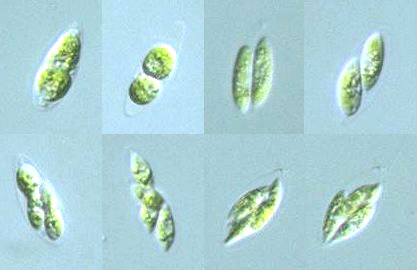

Chlorophyceae: Chlamydomonadales (Volvocales): Chlamydomonadaceae
Chlamydophyceae: Chlamydomonadales: Haematococcaceae
Volvocida: Chlamydomonadina: Chlamydomonadidae
Chlorogonium capillatum
Nozaki, Watanabe et Aizawa 1995
identified by Takashi Nakada (
Department of Biological Sciences,
Graduate School of Science,
University of Tokyo)
 Genus (Ehrenberg): Cells usually fusiform; both ends hyaline; two euqal-length flagella, about
1/2 as long as cell; eye spot present in most species; two or several contractile vacuoles; transverse division
to form 4 zoospores; nutrition phototrophic or chemo-organotrophic (Illustrated Guide, 1985).
Genus (Ehrenberg): Cells usually fusiform; both ends hyaline; two euqal-length flagella, about
1/2 as long as cell; eye spot present in most species; two or several contractile vacuoles; transverse division
to form 4 zoospores; nutrition phototrophic or chemo-organotrophic (Illustrated Guide, 1985).
Species:
Cell body fusiform or ovoid, 30-52 μm long, not tapered at both ends, cell wall thin,
chloroplasts elongated cup-shaped, with many (-12) pyrenoids, both ends not pointed,
stigma ovoidal, located at anterior half of the cell body, many contractile vacuoles
(An Illustrated Guide to Freshwater Zooplankton in Japan, 2000).
|
Chlorogonium capillatum Nozaki, Watanabe et Aizawa 1995, identified by T. Nakada,
cell division, 24-31 μm long,
cell fusiform (spindle-shaped), both ends hyaline, two euqal-length flagella,
x 640, Japan, 199? by Y. Tsukii
 50 μm
50 μm
 100 μm
100 μm
 150 μm; x 400 :
150 μm; x 400 :
 31 μm
31 μm
 63 μm
63 μm
 94 μm; x 640
94 μm; x 640










Chlorogonium neglectum Pascher, 1927 (Syn.: Chlamydomonas neglecta (Pascher) Korshikov, 1938):
Cell body fusiform or ovoid, 11-19 μm long, cell wall thin,
chloroplasts plate-like, with a single pyrenoid located at the center of the cell body,
both ends not pointed, stigma ovoid or ellipsoidal in shape, located at anterior half of the cell body, many contractile vacuoles
(An Illustrated Guide to Freshwater Zooplankton in Japan, 2000).
Chlorogonium elongatum (Dangeard) Francé, 1897:
Cell body fusiform or elongated ovoid, 20-53 μm long, tapered at both ends, cell wall thin,
chloroplasts plate-like,
with two large pyrenoids one located at anterior half and another at posterior half,
stigma ovoid or pear-shaped, located at anterior 1/4-1/3 of the cell body, many contractile vacuoles
(An Illustrated Guide to Freshwater Zooplankton in Japan, 2000).
* Chlorogonium euchlorum Ehrenberg, 1837:
Cell body fusiform or elongated ovoid, 17-59 μm long, tapered at both ends, cell wall thin,
chloroplasts plate-like, with 2-8 pyrenoids,
stigma ovoid or nearly spherical, located at anterior 1/6-1/4 of the cell body, many contractile vacuoles
(An Illustrated Guide to Freshwater Zooplankton in Japan, 2000).
Cell body 25-70(-100) μm long, 4-15(-20) μm wide
(Ettl, Chlorophyta I, Süßwasserflora von Mitteleuropa Band 9, 1983).
Cell body 60-80 μm long, 8-12 μm wide, 4-8 pyrenoids
(Illustrations of The Japanese Fresh-water Algae, 1977).
Chlorogonium capillatum Nozaki, Watanabe et Aizawa, 1995:
Cell body fusiform or ovoid, 30-52 μm long, not tapered at both ends, cell wall thin,
chloroplasts elongated cup-shaped, with many (-12) pyrenoids, both ends not pointed,
stigma ovoidal, located at anterior half of the cell body, many contractile vacuoles
(An Illustrated Guide to Freshwater Zooplankton in Japan, 2000).
Chlorogonium fusiforme Matvienko, 1938:
Cell body fusiform, 16-27 μm long, not tapered at both ends, cell wall thin,
chloroplasts plate-like, with a single pyrenoid located at the center of the cell body,
stigma circular or ellipsoidal, located at anterior half of the cell body, many contractile vacuoles
(An Illustrated Guide to Freshwater Zooplankton in Japan, 2000).
Chlorogonium ellipsoideum Skvortzow & Noda, 1967:
Cell body 11-33 μm long, not tapered at both ends, cell wall thick,
chloroplasts plate-like, without pyrenoids,
stigma elongated in shape, located at equator of the cell, several contractile vacuoles
(An Illustrated Guide to Freshwater Zooplankton in Japan, 2000).
Chlorogonium latilaneolatum Skvortzow & Noda, 1967:
Cell body fusiform, 20-25 μm long, posterior end slightly tapered, cell wall thin,
chloroplasts plate-like, without pyrenoids, stigma located at anterior half of the cell body,
contractile vacuoles 2-5
(An Illustrated Guide to Freshwater Zooplankton in Japan, 2000).
Chlorogonium ovatum Skvortzow & Noda, 1967:
Cell body 10-37 μm long, both ends not tapered, cell wall thick,
chloroplasts reticulated, without pyrenoids, without stigma, contractile vacuoles indistinguishable
(An Illustrated Guide to Freshwater Zooplankton in Japan, 2000).
Please click on images for viewing enlarged.
Copyright
Protist Information Server
 Genus (Ehrenberg): Cells usually fusiform; both ends hyaline; two euqal-length flagella, about
1/2 as long as cell; eye spot present in most species; two or several contractile vacuoles; transverse division
to form 4 zoospores; nutrition phototrophic or chemo-organotrophic (Illustrated Guide, 1985).
Genus (Ehrenberg): Cells usually fusiform; both ends hyaline; two euqal-length flagella, about
1/2 as long as cell; eye spot present in most species; two or several contractile vacuoles; transverse division
to form 4 zoospores; nutrition phototrophic or chemo-organotrophic (Illustrated Guide, 1985).









